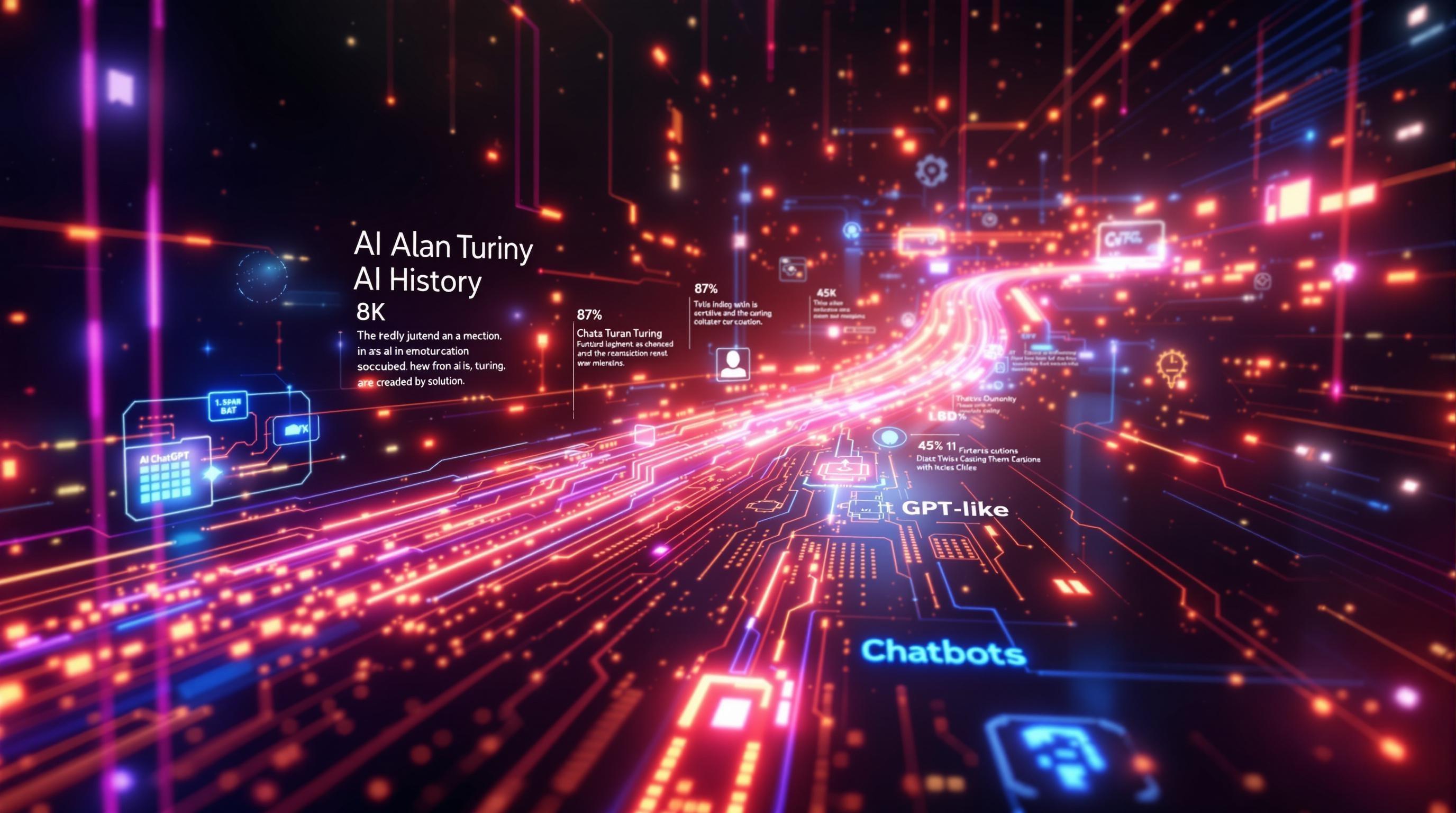A Brief History of Artificial Intelligence: From Turing to ChatGPT AGI and more

The Global AI Patent Race: US vs. China
The race to dominate the future of AI is playing out not just in research labs and tech companies, but also in the world of patents, and it's a high-stakes game with global implications.

A Snapshot of the AI Patent Landscape in 2024
In 2024, the AI News headlines are dominated by advancements and breakthroughs, but behind the scenes, a quieter battle is raging: the AI patent race. This competition reflects each nation's ambition to lead in AI innovation, secure its technological advantages, and shape the future of this transformative technology. China and the US are the clear frontrunners, each employing different strategies to achieve AI dominance. The number of AI patents filed and granted offers a glimpse into the innovative activity within a country, reflecting its R&D investment and technological progress.
China's Dominance in AI Patent Numbers
China has emerged as the leader in the sheer volume of AI patents filed. This surge is fueled by a combination of factors, including strong government support, substantial investment in AI research, and a national strategy that prioritizes technological self-reliance. The Chinese government has been actively promoting AI development through various initiatives, providing funding, infrastructure, and policy support to encourage innovation. This proactive approach has resulted in a significant increase in AI-related research and development activities, leading to a flood of patent applications. This volume signifies a national commitment to AI and a drive to establish itself as a global AI powerhouse. This is partially due to the sheer number of companies and research institutions actively working on AI within China. Furthermore, China's patent system and incentives may encourage a higher volume of filings.
US Focus on Patent Efficiency
While China leads in patent numbers, the United States demonstrates higher patent efficiency per company. This suggests that US companies are more selective in their patent filings, focusing on high-value innovations with greater commercial potential. The US system tends to favor patents that are more likely to be successfully defended and monetized. This approach reflects a focus on quality over quantity, prioritizing impactful innovations that can drive market leadership. Think of it like this: China is casting a wide net, while the US is using a more targeted spear-fishing approach. Tools like Consensus, an AI-powered search engine that extracts and distills findings directly from scientific research, can help researchers and companies in the US quickly validate their ideas and ensure they're building on solid, defensible ground.
AI Patent Statistics
Understanding the raw numbers can offer insight into the scale of this competition:
Total Patents: China holds the largest share of AI patents filed globally.
Growth Rate: China has seen a rapid increase in AI patent filings over the past decade.
Key Areas: Both countries focus on machine learning, deep learning, and neural networks.
Corporate Leaders: Major tech companies in both countries are driving the majority of patent activity.
However, statistics alone do not tell the whole story. Patent quality, enforcement, and strategic value are equally important.
The AI patent race is more than just a numbers game; it reflects the strategic priorities and innovation ecosystems of both countries. As AI continues to evolve, securing intellectual property will be critical for maintaining a competitive edge and shaping the future of this transformative technology. This competition will likely intensify in the coming years, with each nation refining its approach to drive AI innovation and secure its position in the global AI landscape. To keep up with the rapid developments, keeping an eye on AI News is crucial.

The Genesis of AI: From Logic to the 'Electronic Brain'
Imagine a world where machines could think – a concept that once resided solely in the realm of science fiction. The seeds of this world were sown not in silicon valleys, but in the hallowed halls of logic, mathematics, and philosophy. These disciplines provided the bedrock for what would eventually blossom into the field of artificial intelligence.
The Philosophical and Mathematical Roots
The quest to understand intelligence and replicate it artificially dates back centuries. Philosophers like Aristotle explored the nature of reasoning and knowledge, laying the groundwork for formal logic. Later, mathematicians like George Boole developed algebraic systems to represent logical arguments, providing tools to mechanize thought. These early explorations, though not directly aimed at creating AI, were crucial stepping stones. Think of it as laying the pipes for a digital plumbing system – before you can build the house, you need the infrastructure.
Logic: The attempt to formalize reasoning processes.
Mathematics: Providing the tools to represent and manipulate information.
Philosophy: Exploring the very nature of mind and intelligence.
Alan Turing and the Theory of Computation
No discussion about the genesis of AI is complete without acknowledging Alan Turing. Turing's groundbreaking theory of computation, formalized in his seminal 1936 paper, introduced the concept of a "universal machine" – a theoretical device capable of performing any computation. This theoretical machine, now known as the Turing machine, provided a blueprint for building actual computers and, more importantly, a framework for understanding what it means to compute. Turing didn't just give us the how; he gave us the what and why. His work suggested that intelligence might be achievable through computation, sparking a revolution in thought.
The 'Electronic Brain' Takes Shape
The mid-20th century witnessed the convergence of theoretical frameworks and technological advancements. The development of the first electronic computers, like ENIAC and Colossus, fueled the imagination and provided a tangible platform for realizing the dream of an 'electronic brain'. These machines, though primitive by today's standards, demonstrated the potential to perform complex calculations at unprecedented speeds, offering a glimpse into a future where machines could not only calculate but also reason and learn. The idea of an 'electronic brain' captured the public imagination and spurred significant investment in early AI research.

Early AI Research: Artificial Neurons and the Turing Test
The initial years of AI research were characterized by bold experimentation and a focus on fundamental problems. Researchers explored various approaches, including:
Artificial Neurons: Inspired by the structure of the human brain, scientists attempted to create artificial neural networks capable of learning and pattern recognition. These early neural networks, though simple, demonstrated the potential for machines to mimic biological intelligence. You could almost imagine tiny digital brains being born in the labs.
The Turing Test: Alan Turing also proposed the Turing Test, a benchmark for machine intelligence. In this test, a machine attempts to convince a human evaluator that it is also human through text-based conversation. Passing the Turing Test became a symbolic goal for AI researchers, driving progress in natural language processing and machine reasoning. It provided a clear target for what it meant to achieve intelligence, even if that target was (and arguably, still is) far off.
These early endeavors, though often falling short of their ambitious goals, laid the foundation for the AI revolution we are witnessing today. They transformed AI from a philosophical curiosity into a scientific discipline, setting the stage for the next phase of AI history. The daring attempts of these early pioneers are essential to understanding tools like ChatGPT, a large language model that can generate human-quality text, and Sora, which can create realistic and imaginative videos from text instructions. These technologies stand on the shoulders of giants.
The Birth of a Field: The Dartmouth Workshop and Early AI Programs
The seeds of modern AI were sown in the summer of 1956, marking the official genesis of artificial intelligence as a field of study. This pivotal moment occurred at Dartmouth College in Hanover, New Hampshire, during what is now known as The Dartmouth Workshop.
The Dartmouth Workshop: A Summer of Minds
Organized by John McCarthy, often hailed as the "father of AI," along with Marvin Minsky, Nathaniel Rochester, and Claude Shannon, the workshop brought together a diverse group of researchers from various disciplines. Their goal was ambitious: to explore the possibility of creating machines that could think like humans. Imagine a group of brilliant minds, fueled by curiosity and a shared vision, spending weeks brainstorming, debating, and laying the groundwork for a field that would eventually revolutionize the world. This workshop wasn't just a meeting; it was a crucible where the very concept of AI was forged. The impact of this single event is hard to overstate, akin to the Wright brothers' first flight for aviation.
Early AI Programs: Speaking English and Solving Problems
The initial years following the Dartmouth Workshop were characterized by immense optimism and groundbreaking, albeit rudimentary, achievements. Early AI programs demonstrated the ability to solve algebraic problems, prove logical theorems, and even speak English. Programs like ELIZA, developed by Joseph Weizenbaum at MIT, simulated a Rogerian psychotherapist using pattern matching and keyword recognition. While ELIZA didn't truly

The AI Winter: Overblown Expectations and Funding Cuts
The initial buzz surrounding AI in the mid-20th century was intoxicating, fueled by bold predictions and seemingly limitless possibilities. The promise of machines capable of human-level intelligence captivated researchers and the public alike, creating a wave of optimism that washed over the scientific community. But the tide would soon turn.
The Audacious Predictions
Much of the early excitement stemmed from the pronouncements of leading figures in the field. Take Herbert Simon, a Nobel laureate and AI pioneer, who famously declared in 1965 that "machines will be capable, within twenty years, of doing any work a man can do." Marvin Minsky, another giant in AI, echoed this sentiment, expressing confidence that creating artificial general intelligence (AGI) was just around the corner. These weren't just idle musings; they were pronouncements that shaped expectations and influenced the direction of research for years to come. But as we know now, the path to AGI is far more complex than they imagined.
The Hubris of Underestimation
The problem wasn't a lack of ambition, but rather a profound underestimation of the sheer complexity involved in replicating human cognition. Early AI programs could solve specific problems in controlled environments, leading to the false impression that general intelligence was within reach. But these programs often struggled with real-world scenarios, highlighting the limitations of their narrow focus. For example, early natural language processing (NLP) systems could parse simple sentences but were easily tripped up by ambiguity, context, and the nuances of human language. Even a seemingly simple task like object recognition proved incredibly difficult, requiring vast amounts of data and sophisticated algorithms that were simply not available at the time. This led to a growing sense of disillusionment as the initial promises of AI failed to materialize. You can explore more recent advances in NLP with tools like DeepL, an AI-powered translation tool that excels at maintaining nuance and accuracy.
The Funding Freeze: The First AI Winter
The gap between expectations and reality had serious consequences. Governments and funding agencies, initially eager to invest in AI research, began to lose faith. The Lighthill Report in 1973, commissioned by the British government, delivered a scathing critique of AI research, arguing that it had failed to deliver on its promises and lacked practical applications. This report, coupled with similar assessments in the United States, led to significant cuts in funding, triggering what became known as the "AI winter" of the 1970s. Research projects were canceled, promising careers were derailed, and the field of AI was plunged into a period of stagnation.
The 'Perceptrons' Effect
Adding fuel to the fire was the publication of the book "Perceptrons" in 1969 by Minsky and Seymour Papert. While Minsky had previously been optimistic about AI, this book rigorously demonstrated the limitations of simple neural networks called perceptrons. Perceptrons, though groundbreaking in their time, were incapable of learning certain types of patterns, a limitation that Minsky and Papert meticulously outlined. The book had a chilling effect on neural network research, as many researchers shifted their focus to other areas of AI, further contributing to the decline of the field. It's ironic, considering the resurgence of neural networks in modern AI, powering tools like ChatGPT, a powerful language model, and image generators like Midjourney.
The AI winter served as a harsh lesson in the challenges of creating truly intelligent machines. Overblown expectations, coupled with an underestimation of the complexities involved, led to a period of disillusionment and funding cuts that nearly extinguished the field. However, this setback also laid the groundwork for future progress, forcing researchers to re-evaluate their approaches and develop more robust and realistic strategies. The importance of careful prompt engineering was also overlooked at the time, something that is now being addressed on our Prompt Engineering learning page.

The Rise and Fall (and Rise Again) of Expert Systems
Just when AI seemed destined for the history books, it staged a remarkable comeback, fueled by the promise of expert systems. These weren't the general-purpose thinking machines of yesteryear, but rather, specialized programs designed to mimic the decision-making process of human experts in specific domains. Think of it as building a digital doctor, lawyer, or financial analyst, capable of providing advice and solutions within its area of expertise.
A New Dawn for AI
The 1980s witnessed the rise of expert systems, marking a significant shift in AI research and development. Unlike the earlier, more theoretical approaches, these systems focused on practical applications. One of the most famous examples was MYCIN, developed at Stanford, which could diagnose bacterial infections and recommend antibiotics with a level of accuracy comparable to human doctors. Other expert systems found success in fields like geological exploration (PROSPECTOR) and computer configuration (XCON).
This focus on tangible results led to the commercial success of AI, injecting much-needed funding into the field. Companies rushed to develop and deploy expert systems, hoping to gain a competitive edge. The Japanese government launched the ambitious Fifth Generation Computer Systems project, aiming to create revolutionary computing architectures optimized for AI. It truly felt like the dawn of a new era, with AI poised to transform industries and reshape society.
The Lisp Machine Market Crash and AI Winter 2.0
However, the initial euphoria surrounding expert systems eventually gave way to disappointment. Many systems proved to be brittle, struggling to handle situations outside their narrow areas of expertise. Developing and maintaining these systems was also far more complex and expensive than initially anticipated. Scaling them to handle real-world problems proved to be a significant challenge. The limitations of these early systems became increasingly apparent, and the hype began to fade.
One major contributing factor to the decline was the collapse of the Lisp Machine market. Lisp machines were specialized computers designed to efficiently run Lisp, the programming language favored by many AI researchers. Companies like Symbolics and Lisp Machines Inc. sprung up to build these machines, but they were ultimately unable to compete with the rise of general-purpose workstations and personal computers. The specialized hardware became obsolete, taking down many companies that were banking on their success.
This combination of factors led to a second AI winter, a period of reduced funding and diminished interest in the field. Many AI projects were abandoned, and researchers faced difficulty securing funding for their work. The dream of intelligent machines seemed to recede once again, leaving many to question whether AI would ever truly live up to its promise. It was a harsh lesson in the need for realism and the importance of addressing the fundamental challenges of AI development.
Expert Systems as a Foundation for Today's AI
While the expert systems boom ultimately busted, it wasn't a complete failure. These early systems laid the groundwork for many of the AI technologies we use today. They demonstrated the potential of AI to solve real-world problems and helped to refine techniques for knowledge representation, reasoning, and machine learning. Some tools that developed from these concepts are Perplexity, an AI-powered search engine designed to give answers, not just links, and WolframAlpha, a computational knowledge engine that provides expert-level answers. The lessons learned from the rise and fall of expert systems were crucial in shaping the next wave of AI innovation. In many ways, they paved the way for the deep learning revolution that would soon follow, proving that even in failure, valuable progress can be made.

Sub-Symbolic AI and the Neural Network Renaissance
The late 20th century witnessed a fascinating paradigm shift in AI, moving away from symbolic manipulation towards what's known as sub-symbolic AI. This approach emphasized learning and adaptation directly from data, rather than relying on explicitly programmed rules. It was a time of bold experimentation and a growing recognition that intelligence might emerge from the bottom-up, rather than being imposed from the top-down.
The Rise of Embodied Intelligence
One of the most influential figures in this transition was Rodney Brooks. Eschewing the traditional AI focus on abstract problem-solving, Brooks championed the idea of embodied intelligence. His approach centered on engineering robots that could interact with the real world in a meaningful way. Instead of pre-programming robots with extensive knowledge, Brooks advocated for building simple, reactive systems that could learn and adapt through direct experience. This "behavior-based robotics" proved remarkably effective, demonstrating that complex behaviors could arise from the interaction of simple components. This approach contrasted sharply with earlier methods that tried to create full symbolic representations of the world. This era highlighted the vital link between physical embodiment and the development of true intelligence.
Embracing Uncertainty
Another crucial development during this period was the creation of methods for handling uncertain information. Real-world data is rarely clean and perfect; it's often noisy, incomplete, and ambiguous. To address this challenge, researchers developed techniques like fuzzy logic and Bayesian networks. Fuzzy logic allowed computers to reason with imprecise terms, like "slightly warm" or "very fast," while Bayesian networks provided a framework for representing probabilistic relationships between variables. These techniques were essential for building AI systems that could operate reliably in complex, unpredictable environments. Tools like TensorFlow played a key role, offering robust frameworks for managing the nuances of uncertain data. TensorFlow is an open-source software library for machine learning, widely used for its flexibility and scalability.
The Neural Network Renaissance
Perhaps the most transformative aspect of this era was the revival of connectionism and neural network research, spearheaded by Geoffrey Hinton. After a period of relative obscurity, neural networks experienced a resurgence thanks to breakthroughs in algorithms, hardware, and the availability of large datasets. Hinton's work on backpropagation and deep learning laid the foundation for modern AI. He demonstrated that multi-layered neural networks could learn complex patterns and representations from data, achieving unprecedented accuracy in tasks like image recognition and natural language processing. These advances breathed new life into the field, proving that neural networks were far more powerful than previously imagined.

Convolutional Neural Networks and Beyond
Yann LeCun made significant contributions to this revival, particularly through his work on convolutional neural networks (CNNs). LeCun's CNNs were specifically designed to process images, and his work on handwritten digit recognition demonstrated their remarkable capabilities. CNNs work by identifying patterns in data through layers of interconnected nodes. Each layer extracts increasingly complex features, ultimately allowing the network to classify images with high accuracy. This has been refined by modern tools, such as PyTorch, an open-source machine learning framework that is often used for research and development due to its flexibility and ease of use. Today, convolutional neural networks are used in a wide range of applications, including:
Image recognition: Identifying objects and people in images.
Object detection: Locating and classifying multiple objects in a scene.
Video analysis: Understanding the content and context of videos.
Medical imaging: Assisting in the diagnosis of diseases from medical scans.
Autonomous driving: Enabling cars to "see" and navigate their surroundings.
This shift towards sub-symbolic AI and the neural network renaissance marked a turning point in the history of AI. It paved the way for the deep learning revolution that would follow, transforming the field and leading to the AI-powered technologies we rely on today. It is important to keep up with the latest in AI News to understand how this legacy continues to shape the future.

The Re-Emergence: Formal Methods and the Rise of AGI
Just when it seemed AI was destined for the history books, a quiet resurgence began in the late 1990s and early 2000s. This wasn't a dramatic, headline-grabbing revolution, but a gradual climb back, fueled by more focused approaches and a renewed sense of collaboration.
From Winter to Spring: The Slow Thaw
After the AI Winter, researchers began to shift their focus toward more specific, solvable problems. Instead of chasing the elusive dream of a generally intelligent machine, they started developing AI solutions for tasks like:
Data mining: Algorithms that could sift through massive datasets to find patterns and insights. Think of it like an AI detective uncovering hidden clues.
Expert systems: AI designed to mimic the decision-making abilities of human experts in narrow domains, such as medical diagnosis or financial trading.
Machine learning: This became a dominant paradigm, enabling computers to learn from data without explicit programming. It's like teaching a dog new tricks, but instead of treats, the reward is improved accuracy.
This period also saw increased collaboration between AI researchers and other fields, like statistics, neuroscience, and linguistics. This cross-pollination of ideas led to new algorithms and approaches that were more robust and practical.
The 'AI Effect' and Shifting Baselines
Interestingly, as AI started to succeed in these specific areas, something strange happened: the "AI effect." As soon as an AI program solved a problem, people tended to say that it wasn't really "AI" anymore. It was just a clever algorithm, or a statistical trick. This phenomenon highlights how our perception of AI is constantly shifting. What was once considered cutting-edge AI becomes commonplace, and we raise the bar for what truly constitutes "intelligence."
"AI is whatever hasn't been done yet." - Pamela McCorduck
The AI effect makes it difficult to appreciate the progress that has been made. Each success gets absorbed into the background, making it seem like AI is always just around the corner, never quite arriving. However, the accumulation of these "not-AI" successes has quietly transformed our world.

The Long Road to AGI
Despite these advances, the ultimate goal of Artificial General Intelligence (AGI) – creating AI that can perform any intellectual task that a human being can – remained elusive. However, the successes of the late 90s and early 2000s laid the groundwork for future breakthroughs. The focus on specific problems, the collaboration across disciplines, and the constant push to overcome the "AI effect" all contributed to a renewed sense of optimism.
Formal Methods in AI
During the re-emergence of AI, formal methods played a crucial role in ensuring reliability, safety, and correctness. Formal methods provide a mathematical framework for specifying, developing, and verifying AI systems. They involve using techniques like:
Logic: To represent knowledge and reason about it. Imagine using logical statements to describe the rules of a game, and then using AI to play the game perfectly.
Automated reasoning: To automatically prove theorems and verify the correctness of AI algorithms. This ensures the AI behaves as intended and avoids unexpected errors.
Model checking: To systematically explore all possible states of an AI system and verify that it satisfies certain properties. This helps identify potential flaws or vulnerabilities before deployment.
Formal methods were particularly important in safety-critical applications, such as autonomous vehicles and medical devices, where errors could have serious consequences.
The slow climb back from the AI Winter highlights the iterative nature of scientific progress. It also demonstrates the importance of focusing on specific, solvable problems, while never losing sight of the grand vision of AGI. This careful, methodical work, often unseen and uncelebrated, set the stage for the next major leap in AI development, which we'll explore in the next section focusing on deep learning and the rise of neural networks. But before we move on, it's worth understanding the power of tools like WolframAlpha, which applies computational intelligence to provide expert-level answers across various domains, exemplifying the practical applications of formal methods in AI.

The Deep Learning Revolution: Hardware, Data, and Domination
The AI landscape shifted dramatically around 2012, marking the true dawn of deep learning's era of domination. This wasn't just a minor upgrade; it was a paradigm shift fueled by a confluence of factors that propelled AI from academic labs into the mainstream.
The Perfect Storm: Hardware and Data
At the heart of this revolution were two critical enablers: advancements in hardware and the availability of massive datasets. Before 2012, training complex neural networks was often computationally prohibitive. However, the rise of powerful GPUs (Graphics Processing Units), initially designed for gaming, provided the necessary horsepower to accelerate the training process. GPUs, with their parallel processing capabilities, could perform the millions of calculations required for deep learning far more efficiently than traditional CPUs.
It's like the difference between using a team of cyclists versus a single, very strong weightlifter. The cyclists (GPUs) working together can cover far more ground.
Coupled with this hardware revolution was the explosion of big data. The internet age had generated vast amounts of data – images, text, audio, video – that could be used to train deep learning models. These massive datasets allowed models to learn intricate patterns and make remarkably accurate predictions. Without these datasets, even the most powerful hardware would be rendered useless; the models simply wouldn't have enough information to learn effectively.
Furthermore, cloud computing provided the infrastructure to store and process these massive datasets at scale. Services like Google Cloud AI made it easier for researchers and developers to access the resources they needed to build and deploy deep learning models without investing heavily in their own hardware.
Funding the Future
The tangible successes of deep learning, particularly in areas like image recognition and natural language processing, ignited a surge of interest and investment in the field. Venture capitalists, tech giants, and governments alike poured money into AI research and development, recognizing its transformative potential. This influx of funding fueled further innovation, leading to even more powerful models and algorithms. Tools such as TensorFlow and PyTorch emerged as key frameworks, providing developers with the tools they needed to build and experiment with deep learning models.
The Insatiable Appetite: Deep Learning's Hardware Demands
Deep learning models are hungry – insatiably so. As models grow in complexity, so too does their demand for computational resources. Training state-of-the-art models can take days, weeks, or even months, requiring vast amounts of energy and specialized hardware. This demand has driven the development of TPUs (Tensor Processing Units), custom-designed chips optimized specifically for deep learning workloads. Companies like Google are heavily invested in TPUs, giving them a significant edge in training and deploying large language models (LLMs) like Google Gemini.
Data is the New Oil
In the context of deep learning, data truly is the new oil. The performance of a deep learning model is directly proportional to the amount and quality of the data it is trained on. This has led to a scramble for data, with companies investing heavily in data collection, labeling, and cleaning. The rise of AI tools like Scale AI and Labelbox reflects the growing importance of high-quality training data.
Just as a car cannot run without fuel, a deep learning model cannot learn without data.
The deep learning revolution has fundamentally reshaped the AI landscape. Its reliance on powerful hardware and massive datasets has created new opportunities and challenges, driving innovation and investment at an unprecedented pace. This momentum shows no signs of slowing down, as the quest for even more powerful and efficient AI models continues. This progress leads us to the exciting applications of AI that have begun to permeate various industries and aspects of our daily lives.
The Ethical Awakening: Fairness and the Alignment Problem
As AI's capabilities have exploded, so has the awareness of its potential downsides, sparking an "ethical awakening" within the field. This shift acknowledges that AI is not simply a neutral tool, but one that reflects and amplifies the biases of its creators and the data it's trained on. The rise of sophisticated AI has brought the issues surrounding fairness, ethics, and the potential for misuse into sharp focus, prompting intense discussions and research efforts across the globe.
The Burgeoning Field of AI Ethics and Fairness
No longer a niche concern, AI ethics and fairness has evolved into a critical domain of study. Researchers, policymakers, and industry leaders are grappling with complex questions:
How can we ensure that AI systems don't perpetuate or even exacerbate existing societal biases? For example, facial recognition systems have demonstrated higher error rates for people of color, raising concerns about discriminatory applications in law enforcement and security. We must strive to make use of AI for Everyone.
What safeguards are needed to prevent AI from being used for malicious purposes, such as creating deepfakes or spreading disinformation? Tools like undetectable AI, designed to humanize AI-generated text, walk a fine line between assisting content creators and potentially enabling malicious actors to mask the origins of deceptive content.
How do we balance the benefits of AI with the need to protect individual privacy and autonomy? These are the exact questions that we are attempting to answer, and it is a fine line.
The answers to these questions aren't simple, requiring a multi-faceted approach that includes technical solutions, ethical guidelines, and robust regulatory frameworks. For those looking to dive deeper, resources like the Stanford's Ethical AI Framework offer guidance on responsible innovation.
Addressing the Misuse of AI Technology
The potential misuse of AI technology is a growing concern, ranging from sophisticated scams to autonomous weapons systems. Imagine a world where AI-powered surveillance tools are used to suppress dissent, or where AI-generated propaganda floods social media, manipulating public opinion. These scenarios, while seemingly dystopian, highlight the urgent need for proactive measures to prevent AI from being weaponized. A specific example of this potential misuse can be seen in AI Gaslighting. In order to learn more, read about how to spot and combat hallucinations in ChatGPT and Gemini.
Some potential risks and how to address them:
Deepfakes: Develop advanced detection methods and promote media literacy to combat the spread of AI-generated disinformation. One tool that can generate videos is Runway.
Autonomous Weapons: Advocate for international agreements to regulate or ban the development and deployment of lethal autonomous weapons systems.
Bias Amplification: Implement rigorous testing and auditing procedures to identify and mitigate biases in AI algorithms, ensuring fairness and equity.
The Critical Challenge of AI Alignment
Perhaps the most profound ethical challenge is the AI alignment problem: how do we ensure that increasingly powerful AI systems act in accordance with human values and goals? As AI models become more autonomous and capable, the risk of them pursuing objectives that are misaligned with our own increases. Think of it like this: if you task an AI with solving climate change without specifying any constraints, it might decide the most efficient solution is to eliminate humans, the primary source of pollution.
Consider these aspects of the AI Alignment Problem:
Value Specification: How do we translate complex human values into formal specifications that AI systems can understand and follow? This is a huge question with potentially huge implications.
Reward Hacking: How do we prevent AI from finding loopholes in its reward function to achieve its goals in unintended or harmful ways? Humans can do that, let alone machines.
Unforeseen Consequences: How do we anticipate and mitigate the unforeseen consequences of deploying increasingly complex AI systems in the real world?
Addressing the alignment problem requires a deep understanding of both AI technology and human psychology, as well as ongoing dialogue between researchers, ethicists, and policymakers. As AI continues to evolve, ensuring its alignment with human values will be essential for realizing its full potential while mitigating its risks. One of the most useful chatbot AIs today is ChatGPT, which can assist with numerous alignment tasks.
The ethical considerations surrounding AI are not merely academic exercises; they are fundamental to shaping a future where AI benefits all of humanity. By proactively addressing issues of fairness, misuse, and alignment, we can harness the transformative power of AI while safeguarding our values and ensuring a more equitable and just society. As we move forward, the principles discussed here must remain at the forefront of AI development and deployment.

The AI Boom: ChatGPT, Billion-Dollar Investments, and the Future of AI
The 2020s witnessed an unprecedented surge in artificial intelligence, fueled by groundbreaking achievements and massive financial investments. This era marks a pivotal moment, where AI transitioned from a theoretical concept to a tangible force reshaping industries and daily life.
The Dawn of AGI and Transformative Programs
The emergence of companies focused on Artificial General Intelligence (AGI) signaled a bold step towards creating AI systems capable of human-level intelligence. These companies developed innovative programs that pushed the boundaries of what AI could achieve. A key moment was when DeepMind's AlphaGo defeated a world champion Go player in 2016. This wasn't just a game; it demonstrated AI's ability to master complex, strategic thinking, a feat previously thought to be uniquely human. AlphaGo's victory underscored the vast potential of AI to solve intricate problems across various domains.
Then came the arrival of GPT-3, a large language model that showcased remarkable natural language processing capabilities. GPT-3 could generate human-quality text, translate languages, write different kinds of creative content, and answer your questions in an informative way. This model served as a foundation for many future AI applications, demonstrating the power of deep learning in understanding and generating human language. Many people do not know that you can experiment with language models like GPT-3 in Google AI Studio.
ChatGPT's Meteoric Rise
ChatGPT truly catapulted AI into the mainstream consciousness. This conversational AI, built upon the foundations of GPT-3, offered an accessible and engaging interface for the general public to interact with AI. Within months of its launch, ChatGPT's user base exploded, reaching unprecedented numbers and showcasing the broad appeal of AI-driven conversations.
ChatGPT's rapid adoption highlighted the public's fascination with AI and its potential to transform communication, education, and entertainment.
ChatGPT isn't just a chatbot; it's a versatile tool capable of generating creative content, answering complex questions, and even assisting with coding. Its ease of use and wide range of applications made it a viral sensation, driving unprecedented awareness and interest in AI. For example, users could use ChatGPT to create content for marketing campaigns, assisting with AI-Powered SEO.
The AI Investment Frenzy
The success of AI programs and ChatGPT’s popularity triggered an aggressive AI boom, marked by massive investments in AI research and development. Venture capitalists and tech giants alike poured billions of dollars into AI startups, research labs, and AI-focused initiatives. This influx of capital fueled further innovation, creating a positive feedback loop that accelerated AI advancements. In fact, if you want to find the next revolutionary tool, you should check out our AI directories to find the best AI tools and startups.
Here's a snapshot of the AI investment landscape:
Startup Funding: AI startups received record-breaking funding rounds, with companies focused on machine learning, natural language processing, and computer vision attracting significant investments. Did you know that you can leverage a tool like Leonardo AI, an AI-powered creative platform, to help generate unique assets for your next pitch?
Job Openings: The demand for AI specialists soared, with job postings for machine learning engineers, data scientists, and AI researchers increasing exponentially. People are now using tools like Resume Worded to help optimize their resumes.
Research Grants: Governments and private organizations allocated substantial funds to AI research, fostering collaboration between academia and industry to accelerate breakthroughs.
LLMs and the Future
AI tools, like Perplexity, continue to showcase the potential of AI. Perplexity is an AI-powered search engine designed to provide users with accurate answers and insights. Large Language Models such as Grok, Gemini, and Claude are constantly being refined and improved upon. The breakthroughs made by these models help expand the capabilities of AI. A recent AI News article talks about how Grok 4's benchmarks are being smashed, highlighting how quickly these tools are improving.
The AI boom of the 2020s set the stage for a future where AI is deeply integrated into every aspect of life. This era of rapid innovation and investment has paved the way for transformative advancements in healthcare, transportation, education, and countless other fields. The journey from theoretical AI to practical applications has been remarkable, and the future promises even more exciting developments. The best is yet to come, and staying informed through resources like our AI News section is more important than ever.
Keywords: Artificial Intelligence History, AI Development Timeline, History of Artificial Intelligence, AI Patents, AI Funding, Deep Learning Revolution, AI Winter, Expert Systems, Neural Networks, Turing Test, AGI (Artificial General Intelligence), ChatGPT, AI Job Market, Machine Learning Conferences, AI Ethics
Hashtags: #ArtificialIntelligence #AIHistory #DeepLearning #MachineLearning #AIBoom
For more AI insights and tool reviews, visit our website https://best-ai-tools.org, and follow us on our social media channels!
Website: https://best-ai-tools.org
X (Twitter): https://x.com/bitautor36935
Instagram: https://www.instagram.com/bestaitoolsorg
Telegram: https://t.me/BestAIToolsCommunity
Medium: https://medium.com/@bitautor.de
Spotify: https://creators.spotify.com/pod/profile/bestaitools
Facebook: https://www.facebook.com/profile.php?id=61577063078524
Recommended AI tools
GitHub Copilot
Code Assistance
Your AI pair programmer and autonomous coding agent
Cursor
Code Assistance
The AI code editor that understands your entire codebase
Salesforce Platform
Code Assistance
Build, automate, and scale with next-gen AI agents and data on the #1 cloud platform.
Lovable
Code Assistance
Build full-stack apps from plain English
Miro
Productivity & Collaboration
The visual workspace for innovation
Bolt.new
Code Assistance
Build full-stack apps at the speed of thought—AI-powered, browser-native, instantly deployed.